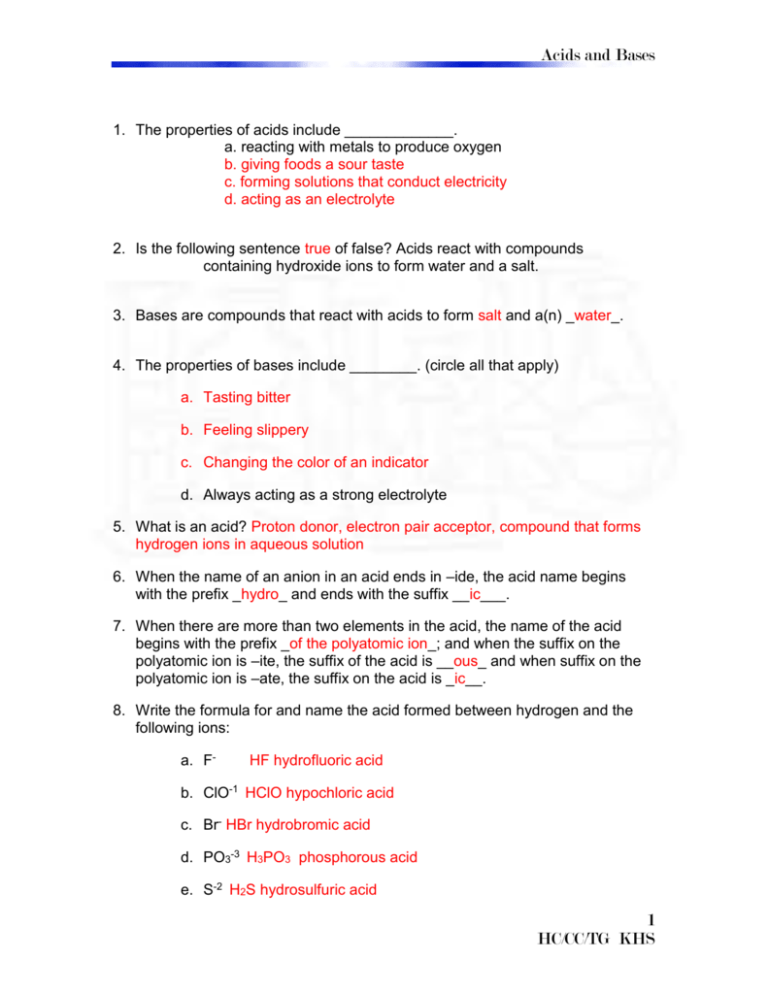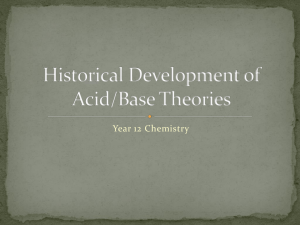16. Which definition of acids and bases is
advertisement

Acids and Bases 1. The properties of acids include _____________. a. reacting with metals to produce oxygen b. giving foods a sour taste c. forming solutions that conduct electricity d. acting as an electrolyte 2. Is the following sentence true of false? Acids react with compounds containing hydroxide ions to form water and a salt. 3. Bases are compounds that react with acids to form salt and a(n) _water_. 4. The properties of bases include ________. (circle all that apply) a. Tasting bitter b. Feeling slippery c. Changing the color of an indicator d. Always acting as a strong electrolyte 5. What is an acid? Proton donor, electron pair acceptor, compound that forms hydrogen ions in aqueous solution 6. When the name of an anion in an acid ends in –ide, the acid name begins with the prefix _hydro_ and ends with the suffix __ic___. 7. When there are more than two elements in the acid, the name of the acid begins with the prefix _of the polyatomic ion_; and when the suffix on the polyatomic ion is –ite, the suffix of the acid is __ous_ and when suffix on the polyatomic ion is –ate, the suffix on the acid is _ic__. 8. Write the formula for and name the acid formed between hydrogen and the following ions: a. F- HF hydrofluoric acid b. ClO-1 HClO hypochloric acid c. Br- HBr hydrobromic acid d. PO3-3 H3PO3 phosphorous acid e. S-2 H2S hydrosulfuric acid 1 HC/CC/TG KHS Acids and Bases 9. Acids are compounds that dissolve in water to form _hydrogen_ ions. 10. Bases are compounds that dissolve n water to form hydroxide ions. 11. What do we call a water molecule that gains a hydrogen ion? Hydronoum ion 12. A hydrogen ion is simply which subatomic particle? proton 13. The reaction in which two water molecules react to form ions is known as the self-ionization of water. 14. True or false: Any aqueous solution in which the [H+] and [OH-] are equal is described as a neutral solution. 15. Explain the following definitions of acids and bases: a. Arrhenius definition acid – substance that releases hydrogen ions in aqueous solution; base substance that releases hydroxide ions in solution b. Bronsted-Lowery definition acid – hydrogen ion (proton) donor; base – hydrogen ion (proton) acceptor c. Lewis definition base – electron pair donor; acid – electron pair acceptor 16. Which definition of acids and bases is solvent dependent? Which solvent is specified? Arrhenius; water 17. Write the equation for the production of the hydronium ion. HOH + HOH H3O+ + OH- 18. What term describes an acid, base of salt which, when dissolved in water conducts and electrical current? Electrolyte 19. The conjugate base of an acid is the particle that remains after a proton has been released by the acid. 20. The conjugate acidof a base is the particle that forms when the base accepts a proton. 2 HC/CC/TG KHS Acids and Bases 21. What is the relationship between an acid and its conjugate base? Acid loses a proton to form conjugate base, conjugate base could add a proton to reform acid between a base and its conjugate acid? Base adds a proton to form conjugate acid, conjugate acid could lose a proton to reform base 22. What is the term for a substance that can act as either an acid or a base? amphoteric 23. What substance is the most common example of the above? water 24. Identify the acid, base, conjugate acid and conjugate base in each of the following: a. H2SO3 + OH- HSO3- + H2 O A B CB CA b. HSO3 + OH S03 + H2O A B CB CA c. HCHO2 + H2O CHO2 + H3O+ A B CB CA + d. C5 H5 N + H2O C5 H5 NH + OHB A CA CB 25. Write the conjugate acid/base of the following: a. NH4+ NH3 b. ClO- HClO c. OH- H2O d. HCl Cle. H30+ H2O f. H2O H30+ or OHH2SO4 SO4-2 26. Write both the conjugate acid and the conjugate base of HSO4- 3 HC/CC/TG KHS Acids and Bases Match the following terms with the correct description. _D__ 27. a base that dissociates completely in solution __E_ 28. an oxide that produces an acid when dissolved in water _C__ _F__ __A__ __B_ 29. an acid that ionizes completely in solution 30. an oxide that produces a base when dissolved in water 31. an acid that dissociates slightly when in solution 32. a base that only partially dissociates in solution A. weak acid B. weak base C. strong acid D. strong base E. acidic anhydride F. basic anhydride 33. Classify each of the following as a strong acid, strong base, weak acid or weak base: a. NaOH SB b. HCl SA c. NH4+ WA d. NH3 WB e. Cl- WB f. HI SA g. H2SO4 SA h. H2CO3 WA i. HNO3 SA 34. Give two properties of an acid and a base that would enable you identify them in the lab Acid – pH <7, electrolyte; base – pH >7, slippery 35. What is a salt? How is it formed? Give 3 examples. Ionic compound that is not an acid or a base, forme from the reaction between an acid and a base, or between an anhydride with and acid or base 36. What is a neutralization reaction? What compound is always a product? reaction between and acid and a base, that forms water and a salt 37. Complete the following neutralization reactions – if the acid is polyprotic, write the reaction in mutilple steps: a. KOH + HCl KCl + H2O b. Ca(OH)2 + HNO3 Ca(NO3)2 + H2O 4 HC/CC/TG KHS Acids and Bases c. H2SO4 + Mg(OH)2 HSO4- + H2O + Mg2+ 2 H2O + MgSO4 d. NaOH + H2CO3 HCO3- + H2O + Na+ 2 H2O + NaOH e. HC2H3O2 + KOH KC2H3O2 + H2O 38. Are all salt solutions neutral? no 39. What is hydrolysis? addition of water 40. In the reactions in question 38, are the salt solutions formed acidic, basic or neutral? A neutral, B neutral, C neutral, D basic, E basic 41. Identify each of the following salts as acidic, basic or neutral in solution? a. K2CO3 basic b. NH4NO3 acidic c. AlCl3 neutral d. KNO3 neutral e. PbSO4 neutral 42. What is the molarity of a solution containing 10.0g of NaOH in 200.0 ml of solution? 1.25M 43. How many grams of NaOH must be dissolved in 300.0 ml of solution to make a 1.3M solution? 15.6 g 44. If 26.4 cm3 of LiOH solution are required to neutralize 21.7 ml of 0.500M HBr, what is the concentration of the basic solution? (1)(21.7ml)(0.500M) = (M)(26.4ml)(1) .41M 45. If 23.4 cm3 of 0.55M NaOH is used to titrate 50.0cm3 of the HCl to the endpoint, what is the concentration of the HCl solution? (1)(M)(50.0 ml) = (0,55M)(23.4 ml)(1) .26M 46. If 75.0 cm3 of 0.823M HClO4 required 95.5 cm3 of Ba(OH)2 for complete neutralization, what is the concentration of the Ba(OH)2 solution? (1)(0.823M)(75.0ml) = (M)(95.5ml)(2) .32M 47. If 40.0 cm3 of 0.106M sulfuric acid neutralized 50.0 cm3 of potassium hydroxide solution, find the concentration of the base? .169M 48. How many ml of 0.18M Al(OH)3 are needed to neutralize 25.0 ml of 0.25M HNO3? 11.6ml 49. How many ml of 0.25M liOH are needed to neutralize 25.0ml of 0.10M H2SO4? 20 ml 5 HC/CC/TG KHS Acids and Bases 50. Write the formulas for the anhydrides of the following: a. H2CO3 CO2 b. H2SO4 SO3 c. H2SO3 SO2 d. NaOH Na2O e. Ca(OH)2 CaO f. HNO3 N2O5 51. True or False: Most pH values are whole numbers. 52. If the [H+] is written in scientific notation, but the coefficient is not 1, what mathematical factor do you need to determine the pH? -log 53. True or False: You can calculate the hydrogen ion concentration of a solution if you know the pH. 54. What is an indicator? solution that changes color at a particular pH 55. When do you use indicators and when do you use a pH meter to measure pH? indicator qualitative, pH meter quantitative 56. How is an indicator a valuable tool in determining pH? determines if a solution is acid or base 57. why do you need many different indicators to span the entire pH spectrum? to identify multiple pH changes 58. What is a buffer and how does it work? solution containing a salt and an acid or base that stabilizes the pH of the solution 59. Define pH and pOH pH – percent hydrogen; pOH – percent hydroxide 60. Find the pH of solutions with the following hydrogen ion concentration: a. 1.00 x 10-3M 3 b. 1.00 x 10-6 M 6 c. 6.49 x 10-10M 9.19 d. 7.01 x 10-6M 5.15 e. 9.47 x 10-8M 7.02 f. 6.89 x 10-14M 13.16 61. Find the hydrogen ion concentration of the following solutions: a. pH = 3.00 1 x 10-3 b. pH = 10.00 1 x 10-10 c. pH = 6.607 2,47 x 10-7 d. pH = 2.253 5,58 x 10-3 e. pH = 6.149 7.10 x 10-7 f. pH = 7.662 2.18 x 10-8 6 HC/CC/TG KHS Acids and Bases 62. Find the pH of the following solutions: a. pOH = 2.00 12 b. pOH = 7.00 7 c. pOH = 1.23 12.77 d. pOH = 1.263 12.737 e. pOH = 4.976 9.024 f. pOH = 9.714 4.286 g. pOH = 3.004 10.996 63. Differentiate between a strong acid and a weak acid. strong acid dissociates to a great degree, weak acid to a lesser degree 64. Distinguish between strong and concentrated acids. strong base dissociates to a great degree, weak base to a lesser degree 65. Given the solutions below: a. b. c. d. e. Solution pH A 2 B 10 C 5 D 1 E 13 Which are acid solutions A,C,D Name the strongest acid and the strongest base Acid – D; Base -E Which has the highest [H3O+]? D Which has the highest [OH-]? E Calculate the [OH-] and the [H3O+] for each solution A [H] = 1 x 10-2; [OH} = 1 x 10-12 C [H] = 1 x 10-5; [OH] = 1 x 10-9 66. What is Ka, Kb. and Kw? a. Write the Ka expressions for HC2H3O2 and H2SO4 b. Write the Kb expressions for an NH3 solution in water. c. Write the Kw expression. 67. In a water solution where 2H2O ↔ OH- + H3O+ 7 HC/CC/TG KHS Acids and Bases 68. 69. 70. a. What happens to the equilibrium if additional OH- is added to the solution? b. What happens to the concentration of H3O+ when additional OH- is added? c. What happens to the pH when additional OH- is added? d. [OH-][H3O+] = ______________ Given the equilibrium HC2H3O2 ↔ H+ + C2H3O2-, if Na C2H3O2 is added to the solution a. Which direction will the equilibrium shift? left b. What happens to the concentration of [H+]? decrease c. What happens to the pH? increase d. Since this solution contains a weak acid and a salt, it is an example of a __buffer_. What is the benefit of this type of solution? e. How could a solution of NH3 be buffered? ammonium salt Using the ionization reaction above for acetic acid, a. Write the Ka expression Ka = [H][C2H3O2] [HC2H3O2] b. Calculate the [H+] for a 0.1M solution of HC2H3O2 if Kb = 1.8 x 10-5 1.8 x 10-5 = [X][X] [0.1M] -4 4.24 x 10 The Ka for HNO2 is 4.6 x 10-4. Find the [H+] in a 0.01M solution. 71. In a 0.3M solution of H2CO3, the concentration of the HCO3- is 3.6 x 10-4M. What is the percent ionization of the H2CO3 molecule? 72. The Ka for HF is 3.53 x 10-4. Find the % ionization in a 0.50M solution. 8 HC/CC/TG KHS








